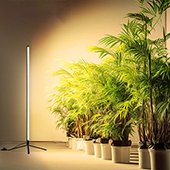
Menu
Novice gardeners may wonder: My regular LED light has a high-lumen output and looks bright. Can I use it instead of growing lights?
Yes, indoor plants can grow under regular LED lights, but not the better light sources for healthy and efficient plant growth.
Although regular LED lights may appear bright, they cannot provide the correct spectrum or intensity for healthy plant growth, making them insufficient for optimizing plant growth.
Lumens are a unit of measurement used to determine the brightness of light for human visibility. For plant growth lights, high-lumen output doesn’t matter for plants. Instead, we need to focus on other parameters like PAR, PPF, PPFD, and PPE, which are essential for promoting plant growth.
If you’re curious about the differences between these metrics, keep reading, and we’ll dive into a deeper understanding.
The process of photosynthesis in plants relies on specific wavelengths and intensities of light that serve as the driving force for plant growth.
For photosynthesis, plants require light in the red and blue spectra. Red light is important for flowering and fruiting, while blue light is crucial for overall plant growth. Apart from these wavelengths, plants also benefit from some amount of green and UV light.
If you want to achieve a complete growth cycle from seed to fruition, using regular LED lights as plant grow lights is not recommended.
Limited Spectrum: Regular LED bulbs often lack specific red and blue wavelengths crucial for plant growth.
Intensity and Distribution: Brightness and light dispersion of regular LEDs may not be optimal for promoting healthy plant growth, as plants may not receive enough light or the required wavelengths.
Inadequate Light Quality: Without the necessary spectrum, plants, even if they survive, may exhibit slow growth, yellowing leaves, poor flowering, and reduced fruiting.
Regular lights serve the purpose of illumination; they are designed as artificial light sources with a spectrum that typically covers a broad range of wavelengths to ensure visibility and color rendering for the human eye.
On the other hand, plant grow lights are specifically designed to provide customized spectra and intensities tailored to meet the precise needs of plants for photosynthesis.
Many LED grow light manufacturers conduct extensive experiments and research thousands of scientific reports on specific light color wavelengths. This enables the production of plant grow lights with the necessary range of wavelengths for optimal growth.
Among these colors, blue and red wavelengths are the most crucial for plants.

Observing the physical growth of plants can determine if regular LED lights can be used as grow lights.
Insufficient Regular Light Exposure
If your plants are not receiving enough regular light, their top leaves may elongate excessively, making them grow tall and spindly. Additionally, the color of the leaves may become lighter. If you notice these signs, it is time to supplement lighting with LED grow lights.
Varied Light Intensity Needs for Different Plants
Different types of plants have varying light intensity requirements. Specific LED grow lights are necessary for indoor cultivation of leafy greens or fruiting plants, as regular LED lights may cause yellowing leaves.
Winter Season in Your Region
During fall and winter, some gardeners bring outdoor plants indoors. LED grow lights can help plants with high light requirements thrive in colder months.
To sum up, regular LED lights are suitable for household lighting and can help with plant growth up to a certain point. However, their broad spectrum may not provide the essential wavelengths and intensities necessary for plant photosynthesis, which limits their potential to optimize indoor plant growth.
Investing in specialized LED grow lights is the most reliable choice for indoor gardening and plant cultivation. This ensures that your plants receive the optimal light required for robust growth and vitality.
From custom light planning, to tailored quotes, and everything in between, our team of horticulture experts are always ready to assist.
Vanten LED
Guzhen, Zhongshan, Guangdong, China
WhatsApp: +86 180 2409 6862
Email: info @ vantenled.com
We are a professional LED plant light manufacturer, committed to using technology to enhance the maximum potential of the lamp, continuously maximizing the benefits for growers, and saving energy for the planet.



